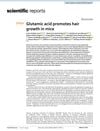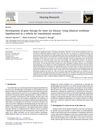TLDR EAAT4 decreases with age, harming skin function and calcium balance.
The study investigates the role of EAAT4 in epidermal differentiation and calcium homeostasis during aging. It was found that the expression of the EAAT4 gene (SLC1A6) significantly decreases with age, leading to an altered calcium gradient in the epidermis. This downregulation affects keratinocyte differentiation and skin barrier function. Experiments using skin explants and reconstructed human epidermis models showed that inhibiting EAAT4 disrupts the calcium gradient and reduces the expression of differentiation markers like loricrin and filaggrin. The findings suggest that EAAT4 is crucial for maintaining calcium homeostasis and proper skin function, and its decline with age contributes to the impaired skin barrier observed in older individuals.
 12 citations
,
July 2021 in “Scientific Reports”
12 citations
,
July 2021 in “Scientific Reports” Glutamic acid helps increase hair growth in mice.
 34 citations
,
April 2018 in “EMBO journal”
34 citations
,
April 2018 in “EMBO journal” The protein SLC1A3 is important for activating skin stem cells and is necessary for normal hair and skin growth in mice.
 6 citations
,
April 2022 in “Biomedicine & pharmacotherapy”
6 citations
,
April 2022 in “Biomedicine & pharmacotherapy” Using three different drugs together may better treat eye diseases like glaucoma and macular degeneration.
 October 2012 in “European Neuropsychopharmacology”
October 2012 in “European Neuropsychopharmacology” People with early psychosis eat more calories, saturated fat, and sugar, and the drug olanzapine may lead to eating even more calories.
 36 citations
,
June 2019 in “eLife”
36 citations
,
June 2019 in “eLife” The study developed a tool to predict how gut microbes process foods and drugs, showing that similar compounds often share metabolic pathways and effects.
 28 citations
,
January 2011 in “Hearing Research”
28 citations
,
January 2011 in “Hearing Research” Gene therapy, especially using atoh1, shows promise for creating functional sensory hair cells in the inner ear, but dosing and side effects need to be managed for clinical application.






